History and Principles of Public Health: PUBH 610 Report
VerifiedAdded on 2021/06/14
|16
|4191
|75
Report
AI Summary
This report, prepared for PUBH 610, focuses on health priority setting in the context of public health. It examines the allocation of healthcare resources and the challenges posed by scarcity, discussing the importance of identifying the health needs of a population. The report compares and contrasts three articles, analyzing data comparison methods, social determinants of health, and the scale of health inequality problems. It also explores how to align health priorities with government targets and assess financial outcomes. Key themes include the identification of health inequities, the role of social determinants, the use of QALY, and the influence of government policies on health spending. The report emphasizes the need for efficient and just resource allocation to improve health outcomes.

Running head: HISTORY AND PRINCIPLES OF PUBLIC HEALTH
Assessment 2- PUBH 610
Name of the Student
Name of the University
Author Note
Assessment 2- PUBH 610
Name of the Student
Name of the University
Author Note
Paraphrase This Document
Need a fresh take? Get an instant paraphrase of this document with our AI Paraphraser
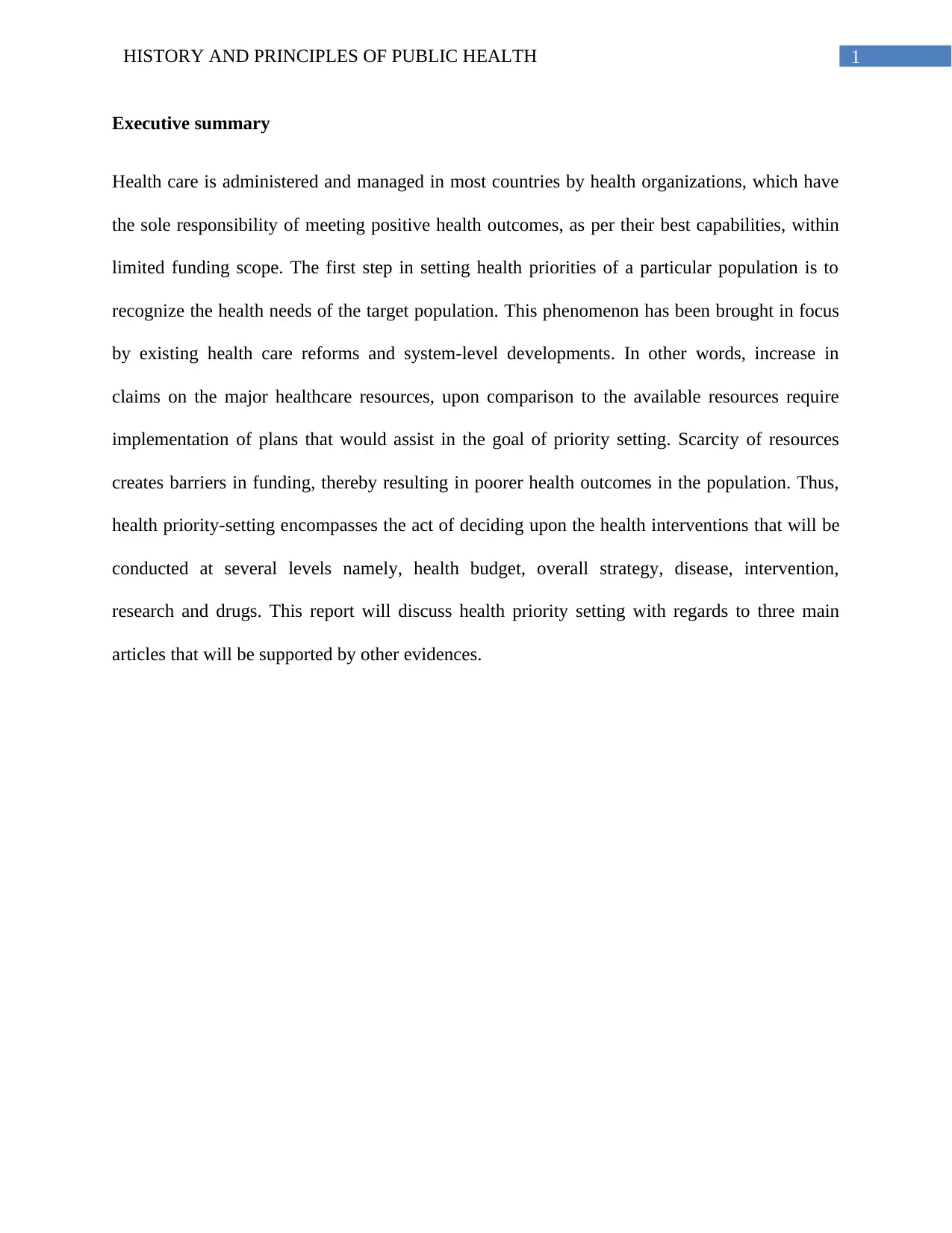
1HISTORY AND PRINCIPLES OF PUBLIC HEALTH
Executive summary
Health care is administered and managed in most countries by health organizations, which have
the sole responsibility of meeting positive health outcomes, as per their best capabilities, within
limited funding scope. The first step in setting health priorities of a particular population is to
recognize the health needs of the target population. This phenomenon has been brought in focus
by existing health care reforms and system-level developments. In other words, increase in
claims on the major healthcare resources, upon comparison to the available resources require
implementation of plans that would assist in the goal of priority setting. Scarcity of resources
creates barriers in funding, thereby resulting in poorer health outcomes in the population. Thus,
health priority-setting encompasses the act of deciding upon the health interventions that will be
conducted at several levels namely, health budget, overall strategy, disease, intervention,
research and drugs. This report will discuss health priority setting with regards to three main
articles that will be supported by other evidences.
Executive summary
Health care is administered and managed in most countries by health organizations, which have
the sole responsibility of meeting positive health outcomes, as per their best capabilities, within
limited funding scope. The first step in setting health priorities of a particular population is to
recognize the health needs of the target population. This phenomenon has been brought in focus
by existing health care reforms and system-level developments. In other words, increase in
claims on the major healthcare resources, upon comparison to the available resources require
implementation of plans that would assist in the goal of priority setting. Scarcity of resources
creates barriers in funding, thereby resulting in poorer health outcomes in the population. Thus,
health priority-setting encompasses the act of deciding upon the health interventions that will be
conducted at several levels namely, health budget, overall strategy, disease, intervention,
research and drugs. This report will discuss health priority setting with regards to three main
articles that will be supported by other evidences.
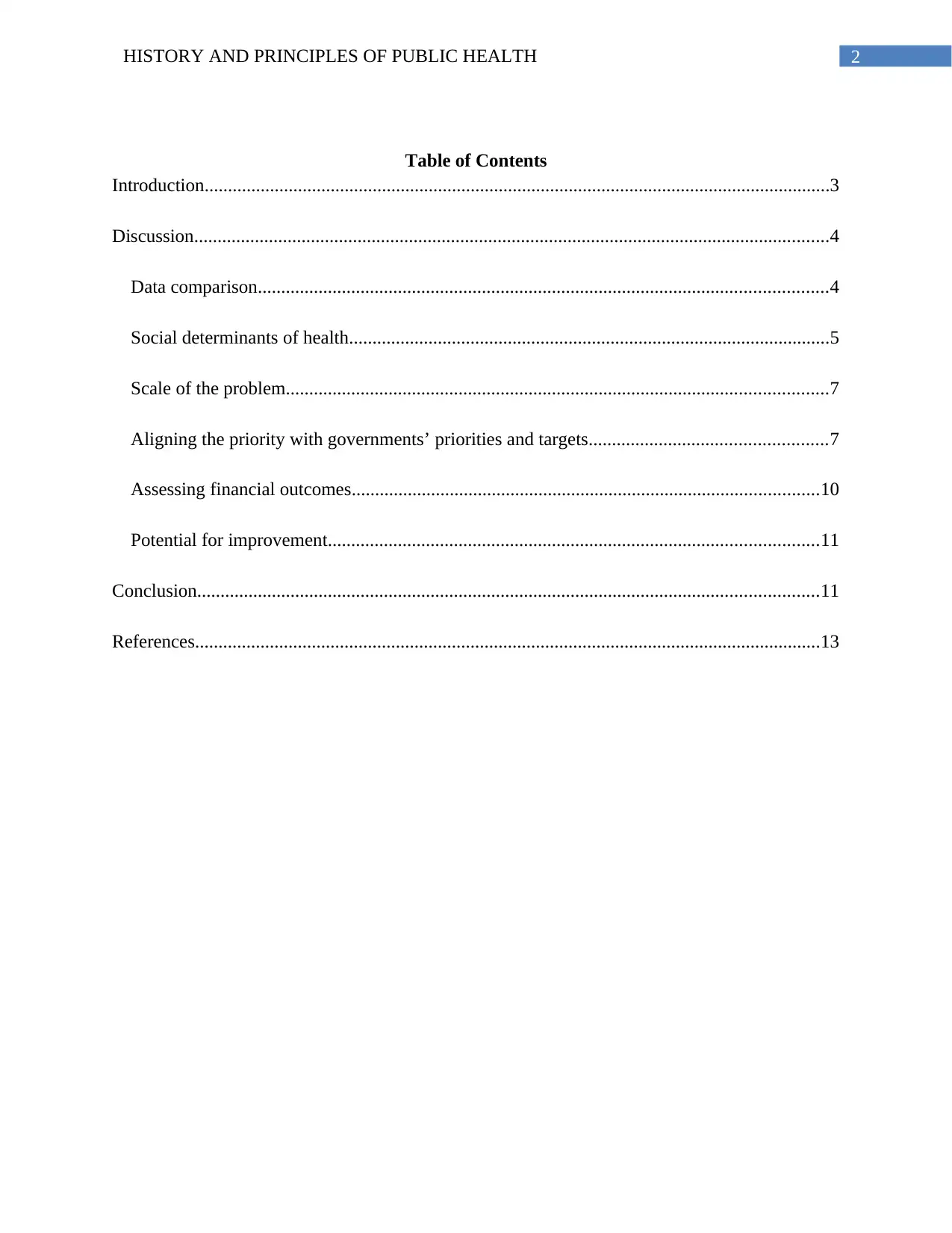
2HISTORY AND PRINCIPLES OF PUBLIC HEALTH
Table of Contents
Introduction......................................................................................................................................3
Discussion........................................................................................................................................4
Data comparison..........................................................................................................................4
Social determinants of health.......................................................................................................5
Scale of the problem....................................................................................................................7
Aligning the priority with governments’ priorities and targets...................................................7
Assessing financial outcomes....................................................................................................10
Potential for improvement.........................................................................................................11
Conclusion.....................................................................................................................................11
References......................................................................................................................................13
Table of Contents
Introduction......................................................................................................................................3
Discussion........................................................................................................................................4
Data comparison..........................................................................................................................4
Social determinants of health.......................................................................................................5
Scale of the problem....................................................................................................................7
Aligning the priority with governments’ priorities and targets...................................................7
Assessing financial outcomes....................................................................................................10
Potential for improvement.........................................................................................................11
Conclusion.....................................................................................................................................11
References......................................................................................................................................13
⊘ This is a preview!⊘
Do you want full access?
Subscribe today to unlock all pages.

Trusted by 1+ million students worldwide
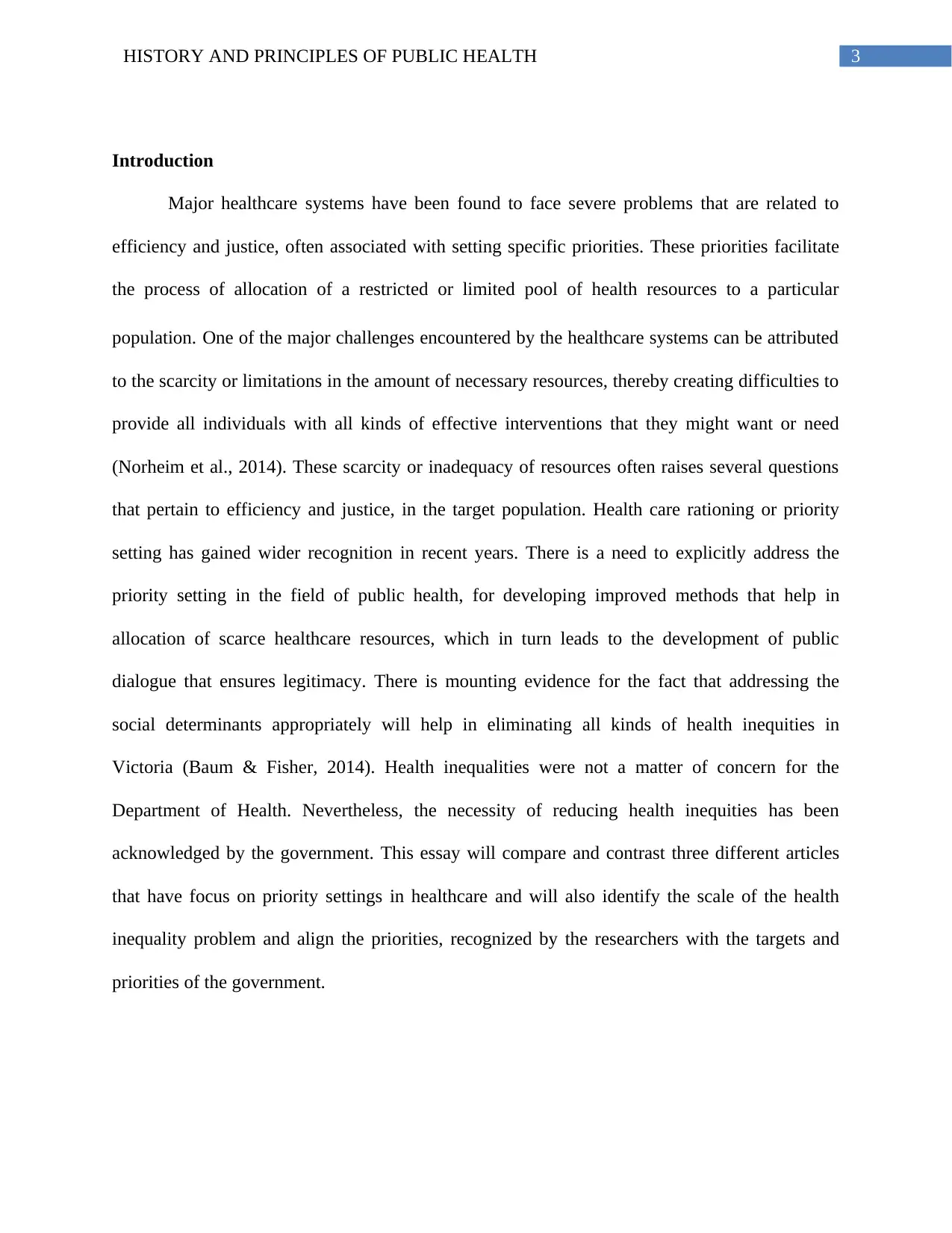
3HISTORY AND PRINCIPLES OF PUBLIC HEALTH
Introduction
Major healthcare systems have been found to face severe problems that are related to
efficiency and justice, often associated with setting specific priorities. These priorities facilitate
the process of allocation of a restricted or limited pool of health resources to a particular
population. One of the major challenges encountered by the healthcare systems can be attributed
to the scarcity or limitations in the amount of necessary resources, thereby creating difficulties to
provide all individuals with all kinds of effective interventions that they might want or need
(Norheim et al., 2014). These scarcity or inadequacy of resources often raises several questions
that pertain to efficiency and justice, in the target population. Health care rationing or priority
setting has gained wider recognition in recent years. There is a need to explicitly address the
priority setting in the field of public health, for developing improved methods that help in
allocation of scarce healthcare resources, which in turn leads to the development of public
dialogue that ensures legitimacy. There is mounting evidence for the fact that addressing the
social determinants appropriately will help in eliminating all kinds of health inequities in
Victoria (Baum & Fisher, 2014). Health inequalities were not a matter of concern for the
Department of Health. Nevertheless, the necessity of reducing health inequities has been
acknowledged by the government. This essay will compare and contrast three different articles
that have focus on priority settings in healthcare and will also identify the scale of the health
inequality problem and align the priorities, recognized by the researchers with the targets and
priorities of the government.
Introduction
Major healthcare systems have been found to face severe problems that are related to
efficiency and justice, often associated with setting specific priorities. These priorities facilitate
the process of allocation of a restricted or limited pool of health resources to a particular
population. One of the major challenges encountered by the healthcare systems can be attributed
to the scarcity or limitations in the amount of necessary resources, thereby creating difficulties to
provide all individuals with all kinds of effective interventions that they might want or need
(Norheim et al., 2014). These scarcity or inadequacy of resources often raises several questions
that pertain to efficiency and justice, in the target population. Health care rationing or priority
setting has gained wider recognition in recent years. There is a need to explicitly address the
priority setting in the field of public health, for developing improved methods that help in
allocation of scarce healthcare resources, which in turn leads to the development of public
dialogue that ensures legitimacy. There is mounting evidence for the fact that addressing the
social determinants appropriately will help in eliminating all kinds of health inequities in
Victoria (Baum & Fisher, 2014). Health inequalities were not a matter of concern for the
Department of Health. Nevertheless, the necessity of reducing health inequities has been
acknowledged by the government. This essay will compare and contrast three different articles
that have focus on priority settings in healthcare and will also identify the scale of the health
inequality problem and align the priorities, recognized by the researchers with the targets and
priorities of the government.
Paraphrase This Document
Need a fresh take? Get an instant paraphrase of this document with our AI Paraphraser
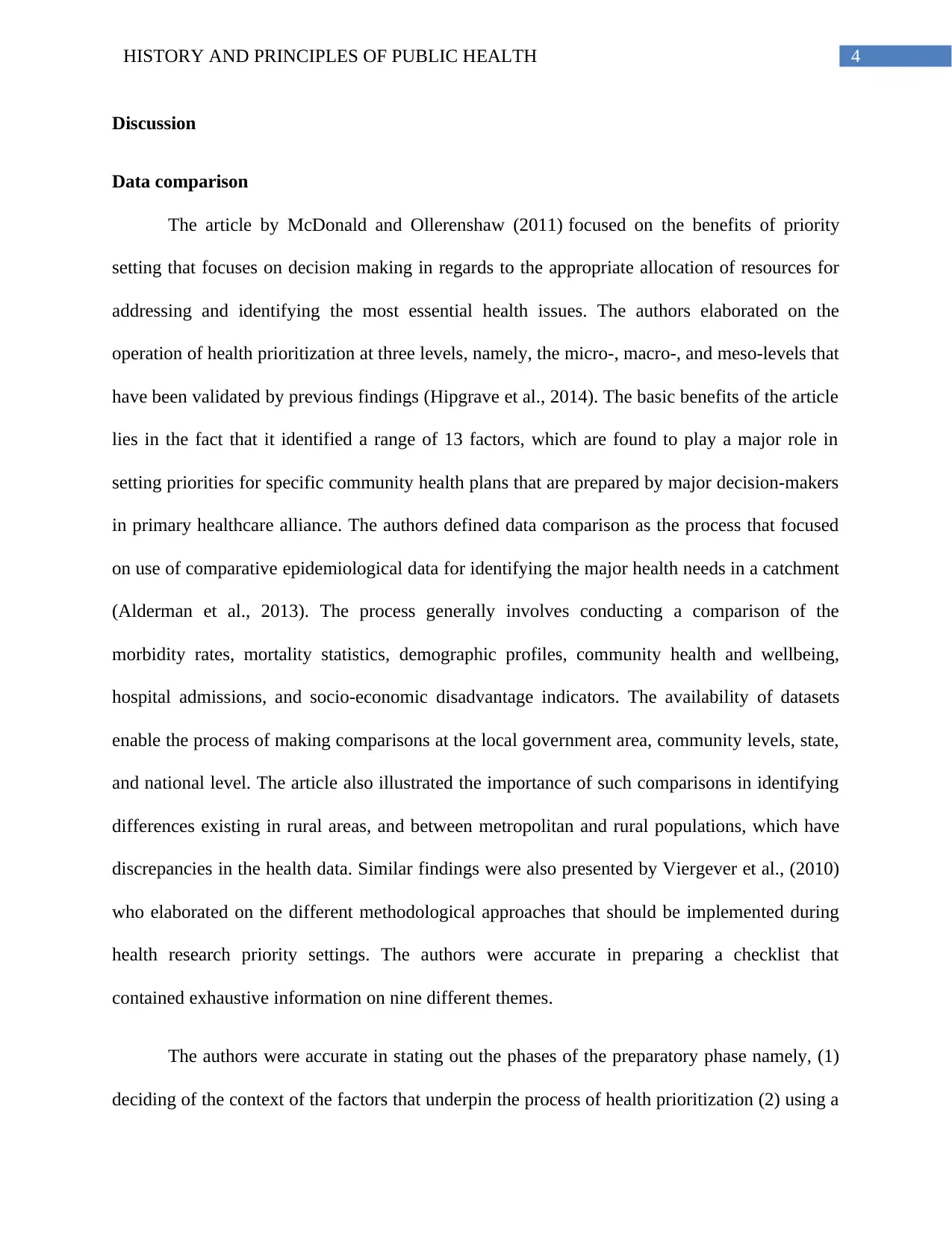
4HISTORY AND PRINCIPLES OF PUBLIC HEALTH
Discussion
Data comparison
The article by McDonald and Ollerenshaw (2011) focused on the benefits of priority
setting that focuses on decision making in regards to the appropriate allocation of resources for
addressing and identifying the most essential health issues. The authors elaborated on the
operation of health prioritization at three levels, namely, the micro-, macro-, and meso-levels that
have been validated by previous findings (Hipgrave et al., 2014). The basic benefits of the article
lies in the fact that it identified a range of 13 factors, which are found to play a major role in
setting priorities for specific community health plans that are prepared by major decision-makers
in primary healthcare alliance. The authors defined data comparison as the process that focused
on use of comparative epidemiological data for identifying the major health needs in a catchment
(Alderman et al., 2013). The process generally involves conducting a comparison of the
morbidity rates, mortality statistics, demographic profiles, community health and wellbeing,
hospital admissions, and socio-economic disadvantage indicators. The availability of datasets
enable the process of making comparisons at the local government area, community levels, state,
and national level. The article also illustrated the importance of such comparisons in identifying
differences existing in rural areas, and between metropolitan and rural populations, which have
discrepancies in the health data. Similar findings were also presented by Viergever et al., (2010)
who elaborated on the different methodological approaches that should be implemented during
health research priority settings. The authors were accurate in preparing a checklist that
contained exhaustive information on nine different themes.
The authors were accurate in stating out the phases of the preparatory phase namely, (1)
deciding of the context of the factors that underpin the process of health prioritization (2) using a
Discussion
Data comparison
The article by McDonald and Ollerenshaw (2011) focused on the benefits of priority
setting that focuses on decision making in regards to the appropriate allocation of resources for
addressing and identifying the most essential health issues. The authors elaborated on the
operation of health prioritization at three levels, namely, the micro-, macro-, and meso-levels that
have been validated by previous findings (Hipgrave et al., 2014). The basic benefits of the article
lies in the fact that it identified a range of 13 factors, which are found to play a major role in
setting priorities for specific community health plans that are prepared by major decision-makers
in primary healthcare alliance. The authors defined data comparison as the process that focused
on use of comparative epidemiological data for identifying the major health needs in a catchment
(Alderman et al., 2013). The process generally involves conducting a comparison of the
morbidity rates, mortality statistics, demographic profiles, community health and wellbeing,
hospital admissions, and socio-economic disadvantage indicators. The availability of datasets
enable the process of making comparisons at the local government area, community levels, state,
and national level. The article also illustrated the importance of such comparisons in identifying
differences existing in rural areas, and between metropolitan and rural populations, which have
discrepancies in the health data. Similar findings were also presented by Viergever et al., (2010)
who elaborated on the different methodological approaches that should be implemented during
health research priority settings. The authors were accurate in preparing a checklist that
contained exhaustive information on nine different themes.
The authors were accurate in stating out the phases of the preparatory phase namely, (1)
deciding of the context of the factors that underpin the process of health prioritization (2) using a
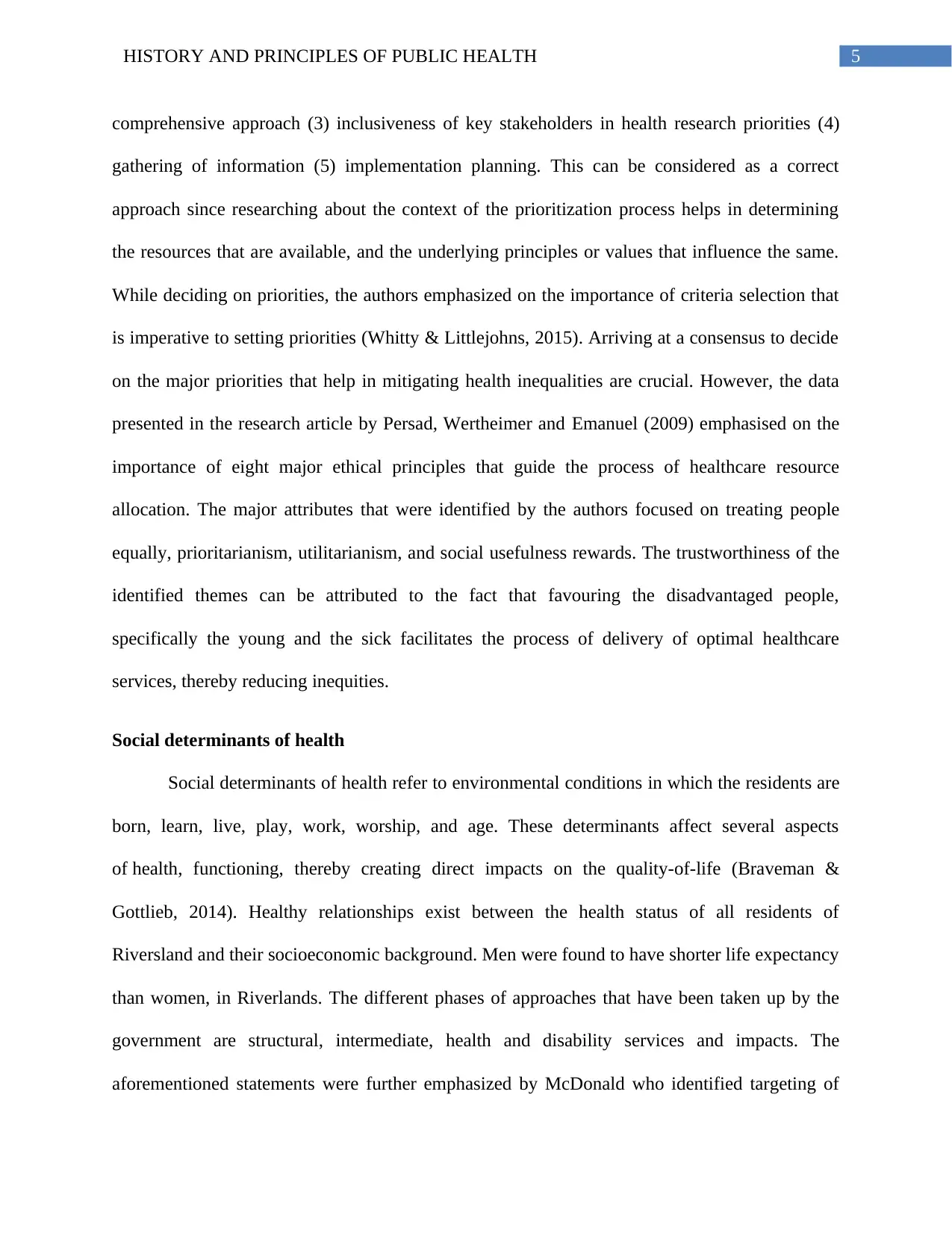
5HISTORY AND PRINCIPLES OF PUBLIC HEALTH
comprehensive approach (3) inclusiveness of key stakeholders in health research priorities (4)
gathering of information (5) implementation planning. This can be considered as a correct
approach since researching about the context of the prioritization process helps in determining
the resources that are available, and the underlying principles or values that influence the same.
While deciding on priorities, the authors emphasized on the importance of criteria selection that
is imperative to setting priorities (Whitty & Littlejohns, 2015). Arriving at a consensus to decide
on the major priorities that help in mitigating health inequalities are crucial. However, the data
presented in the research article by Persad, Wertheimer and Emanuel (2009) emphasised on the
importance of eight major ethical principles that guide the process of healthcare resource
allocation. The major attributes that were identified by the authors focused on treating people
equally, prioritarianism, utilitarianism, and social usefulness rewards. The trustworthiness of the
identified themes can be attributed to the fact that favouring the disadvantaged people,
specifically the young and the sick facilitates the process of delivery of optimal healthcare
services, thereby reducing inequities.
Social determinants of health
Social determinants of health refer to environmental conditions in which the residents are
born, learn, live, play, work, worship, and age. These determinants affect several aspects
of health, functioning, thereby creating direct impacts on the quality-of-life (Braveman &
Gottlieb, 2014). Healthy relationships exist between the health status of all residents of
Riversland and their socioeconomic background. Men were found to have shorter life expectancy
than women, in Riverlands. The different phases of approaches that have been taken up by the
government are structural, intermediate, health and disability services and impacts. The
aforementioned statements were further emphasized by McDonald who identified targeting of
comprehensive approach (3) inclusiveness of key stakeholders in health research priorities (4)
gathering of information (5) implementation planning. This can be considered as a correct
approach since researching about the context of the prioritization process helps in determining
the resources that are available, and the underlying principles or values that influence the same.
While deciding on priorities, the authors emphasized on the importance of criteria selection that
is imperative to setting priorities (Whitty & Littlejohns, 2015). Arriving at a consensus to decide
on the major priorities that help in mitigating health inequalities are crucial. However, the data
presented in the research article by Persad, Wertheimer and Emanuel (2009) emphasised on the
importance of eight major ethical principles that guide the process of healthcare resource
allocation. The major attributes that were identified by the authors focused on treating people
equally, prioritarianism, utilitarianism, and social usefulness rewards. The trustworthiness of the
identified themes can be attributed to the fact that favouring the disadvantaged people,
specifically the young and the sick facilitates the process of delivery of optimal healthcare
services, thereby reducing inequities.
Social determinants of health
Social determinants of health refer to environmental conditions in which the residents are
born, learn, live, play, work, worship, and age. These determinants affect several aspects
of health, functioning, thereby creating direct impacts on the quality-of-life (Braveman &
Gottlieb, 2014). Healthy relationships exist between the health status of all residents of
Riversland and their socioeconomic background. Men were found to have shorter life expectancy
than women, in Riverlands. The different phases of approaches that have been taken up by the
government are structural, intermediate, health and disability services and impacts. The
aforementioned statements were further emphasized by McDonald who identified targeting of
⊘ This is a preview!⊘
Do you want full access?
Subscribe today to unlock all pages.

Trusted by 1+ million students worldwide
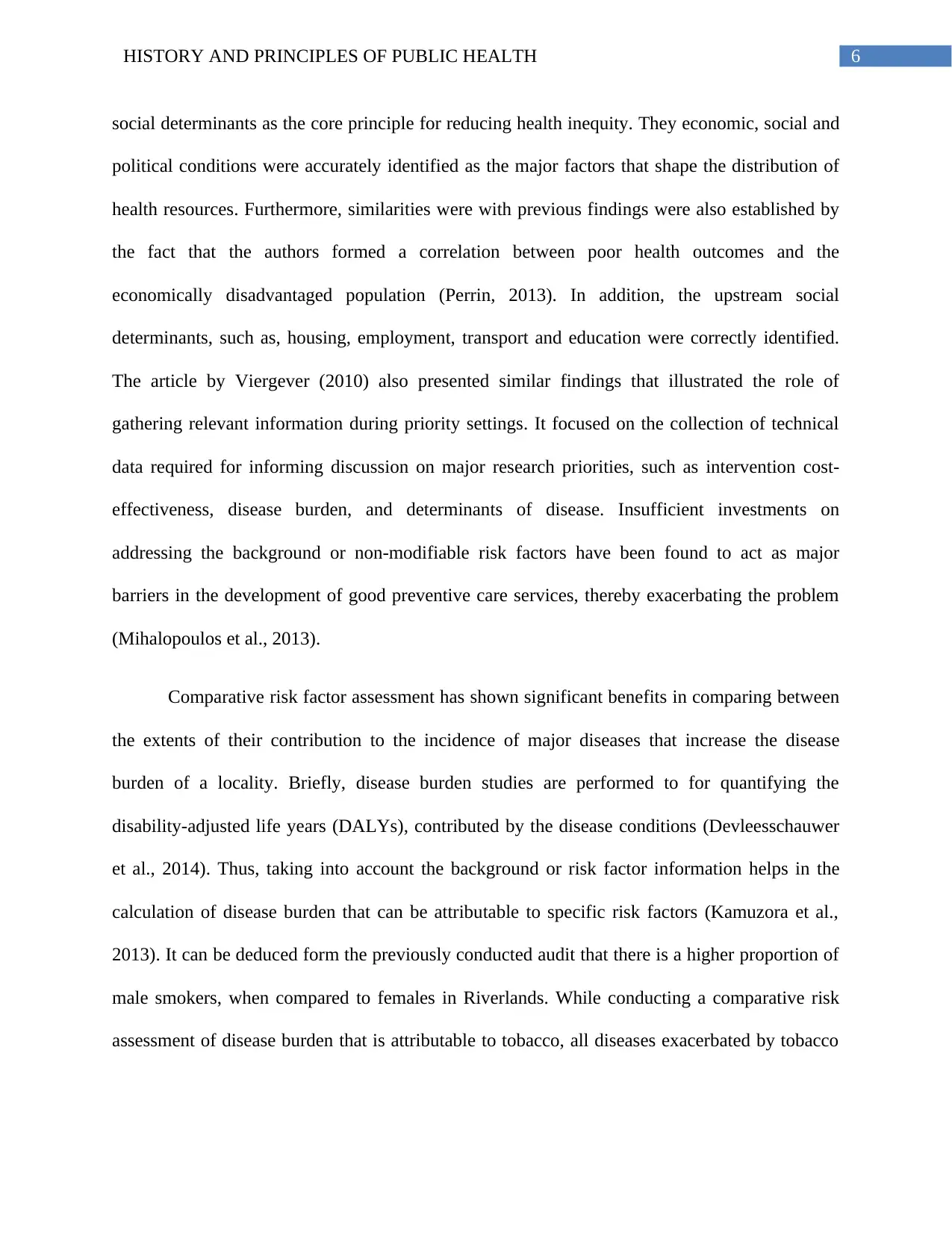
6HISTORY AND PRINCIPLES OF PUBLIC HEALTH
social determinants as the core principle for reducing health inequity. They economic, social and
political conditions were accurately identified as the major factors that shape the distribution of
health resources. Furthermore, similarities were with previous findings were also established by
the fact that the authors formed a correlation between poor health outcomes and the
economically disadvantaged population (Perrin, 2013). In addition, the upstream social
determinants, such as, housing, employment, transport and education were correctly identified.
The article by Viergever (2010) also presented similar findings that illustrated the role of
gathering relevant information during priority settings. It focused on the collection of technical
data required for informing discussion on major research priorities, such as intervention cost-
effectiveness, disease burden, and determinants of disease. Insufficient investments on
addressing the background or non-modifiable risk factors have been found to act as major
barriers in the development of good preventive care services, thereby exacerbating the problem
(Mihalopoulos et al., 2013).
Comparative risk factor assessment has shown significant benefits in comparing between
the extents of their contribution to the incidence of major diseases that increase the disease
burden of a locality. Briefly, disease burden studies are performed to for quantifying the
disability-adjusted life years (DALYs), contributed by the disease conditions (Devleesschauwer
et al., 2014). Thus, taking into account the background or risk factor information helps in the
calculation of disease burden that can be attributable to specific risk factors (Kamuzora et al.,
2013). It can be deduced form the previously conducted audit that there is a higher proportion of
male smokers, when compared to females in Riverlands. While conducting a comparative risk
assessment of disease burden that is attributable to tobacco, all diseases exacerbated by tobacco
social determinants as the core principle for reducing health inequity. They economic, social and
political conditions were accurately identified as the major factors that shape the distribution of
health resources. Furthermore, similarities were with previous findings were also established by
the fact that the authors formed a correlation between poor health outcomes and the
economically disadvantaged population (Perrin, 2013). In addition, the upstream social
determinants, such as, housing, employment, transport and education were correctly identified.
The article by Viergever (2010) also presented similar findings that illustrated the role of
gathering relevant information during priority settings. It focused on the collection of technical
data required for informing discussion on major research priorities, such as intervention cost-
effectiveness, disease burden, and determinants of disease. Insufficient investments on
addressing the background or non-modifiable risk factors have been found to act as major
barriers in the development of good preventive care services, thereby exacerbating the problem
(Mihalopoulos et al., 2013).
Comparative risk factor assessment has shown significant benefits in comparing between
the extents of their contribution to the incidence of major diseases that increase the disease
burden of a locality. Briefly, disease burden studies are performed to for quantifying the
disability-adjusted life years (DALYs), contributed by the disease conditions (Devleesschauwer
et al., 2014). Thus, taking into account the background or risk factor information helps in the
calculation of disease burden that can be attributable to specific risk factors (Kamuzora et al.,
2013). It can be deduced form the previously conducted audit that there is a higher proportion of
male smokers, when compared to females in Riverlands. While conducting a comparative risk
assessment of disease burden that is attributable to tobacco, all diseases exacerbated by tobacco
Paraphrase This Document
Need a fresh take? Get an instant paraphrase of this document with our AI Paraphraser

7HISTORY AND PRINCIPLES OF PUBLIC HEALTH
smoking are recognized, in addition to their relative risks of association between the disease and
smoking, and the population distribution.
Scale of the problem
Priority setting in healthcare also involves recognition of the number of people, living in
a particular region, who are affected by health inequities that directly result in poorer health
outcomes among them. This generally encompasses setting agendas that aim towards common
outcomes that focus on negotiated set of health priorities. This was elaborated by one article that
identified scale of health problems as the number of people, present in a catchment, who are
affected by the problem (directly or indirectly) (McDonald & Ollerenshaw, 2011).
Demographical and epidemiological data play an important role in identifying the scale of health
problem. In addition, the limitations were also appropriately identified owing to the use of
unreliable or outdated data. Similar data were presented by Persad (2009) who illustrated the
insufficiency of maximizing quality-adjusted life-years (QALY) for allocation of health
resource. However, the article accurately identified the differences in QALYs that play an
essential role in determining the basis of prioritizing the delivery health services. This can be
further established by the fact that QALY is a generic measure of disease burden, and includes
both the quantity and quality of life lived (Brennan & Dixon, 2013). Use of QALY in setting
priorities is an important step as it facilitates the process of economic evaluation, which in turn
helps in conducting a financial assessment of the selected medical interventions.
Aligning the priority with governments’ priorities and targets
There are a range of factors that shape the budget allocation and implementation of
government policies while setting health priorities. The outcomes and values that are prioritized
by the policymakers show important implications on health spending, thereby creating direct
smoking are recognized, in addition to their relative risks of association between the disease and
smoking, and the population distribution.
Scale of the problem
Priority setting in healthcare also involves recognition of the number of people, living in
a particular region, who are affected by health inequities that directly result in poorer health
outcomes among them. This generally encompasses setting agendas that aim towards common
outcomes that focus on negotiated set of health priorities. This was elaborated by one article that
identified scale of health problems as the number of people, present in a catchment, who are
affected by the problem (directly or indirectly) (McDonald & Ollerenshaw, 2011).
Demographical and epidemiological data play an important role in identifying the scale of health
problem. In addition, the limitations were also appropriately identified owing to the use of
unreliable or outdated data. Similar data were presented by Persad (2009) who illustrated the
insufficiency of maximizing quality-adjusted life-years (QALY) for allocation of health
resource. However, the article accurately identified the differences in QALYs that play an
essential role in determining the basis of prioritizing the delivery health services. This can be
further established by the fact that QALY is a generic measure of disease burden, and includes
both the quantity and quality of life lived (Brennan & Dixon, 2013). Use of QALY in setting
priorities is an important step as it facilitates the process of economic evaluation, which in turn
helps in conducting a financial assessment of the selected medical interventions.
Aligning the priority with governments’ priorities and targets
There are a range of factors that shape the budget allocation and implementation of
government policies while setting health priorities. The outcomes and values that are prioritized
by the policymakers show important implications on health spending, thereby creating direct
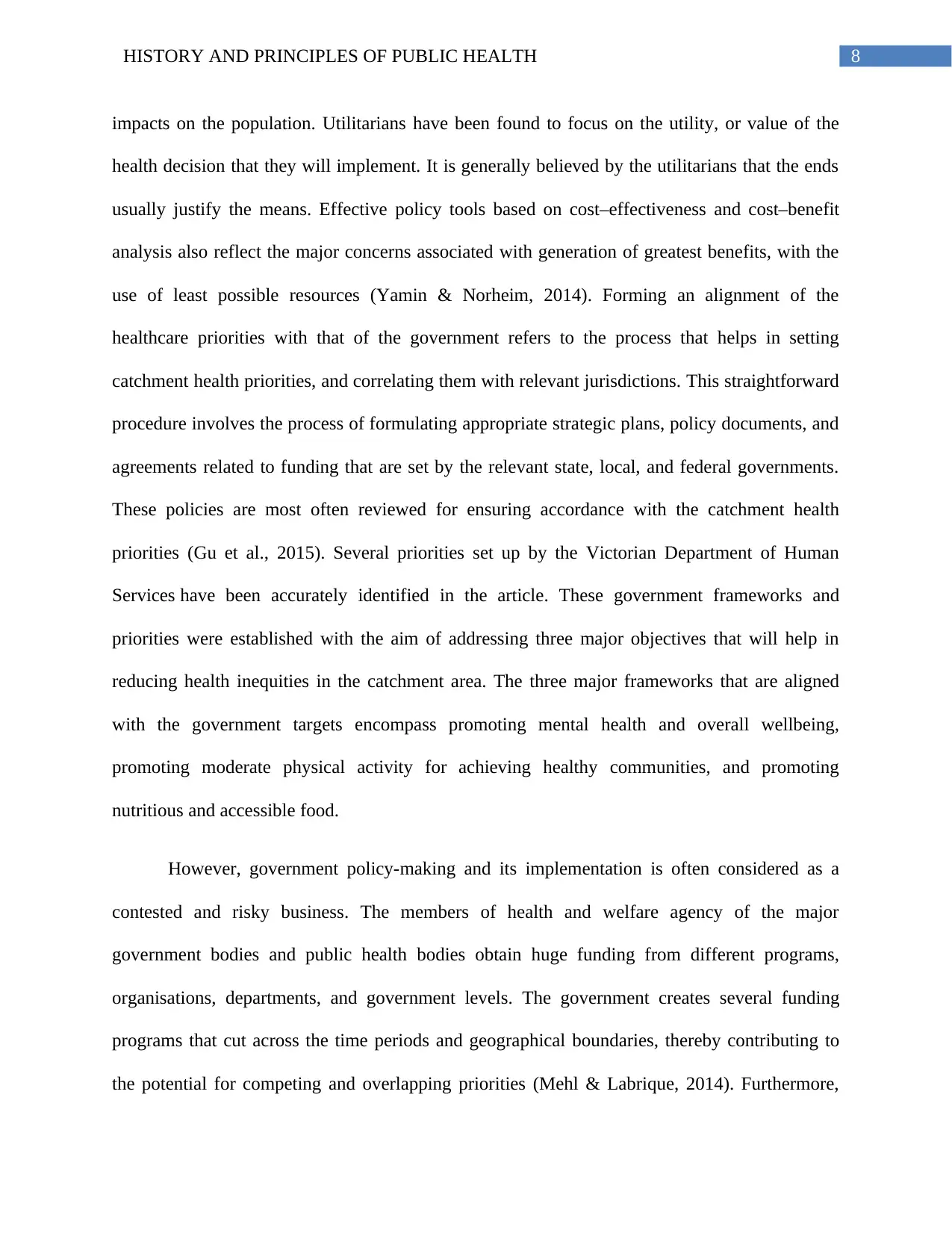
8HISTORY AND PRINCIPLES OF PUBLIC HEALTH
impacts on the population. Utilitarians have been found to focus on the utility, or value of the
health decision that they will implement. It is generally believed by the utilitarians that the ends
usually justify the means. Effective policy tools based on cost–effectiveness and cost–benefit
analysis also reflect the major concerns associated with generation of greatest benefits, with the
use of least possible resources (Yamin & Norheim, 2014). Forming an alignment of the
healthcare priorities with that of the government refers to the process that helps in setting
catchment health priorities, and correlating them with relevant jurisdictions. This straightforward
procedure involves the process of formulating appropriate strategic plans, policy documents, and
agreements related to funding that are set by the relevant state, local, and federal governments.
These policies are most often reviewed for ensuring accordance with the catchment health
priorities (Gu et al., 2015). Several priorities set up by the Victorian Department of Human
Services have been accurately identified in the article. These government frameworks and
priorities were established with the aim of addressing three major objectives that will help in
reducing health inequities in the catchment area. The three major frameworks that are aligned
with the government targets encompass promoting mental health and overall wellbeing,
promoting moderate physical activity for achieving healthy communities, and promoting
nutritious and accessible food.
However, government policy-making and its implementation is often considered as a
contested and risky business. The members of health and welfare agency of the major
government bodies and public health bodies obtain huge funding from different programs,
organisations, departments, and government levels. The government creates several funding
programs that cut across the time periods and geographical boundaries, thereby contributing to
the potential for competing and overlapping priorities (Mehl & Labrique, 2014). Furthermore,
impacts on the population. Utilitarians have been found to focus on the utility, or value of the
health decision that they will implement. It is generally believed by the utilitarians that the ends
usually justify the means. Effective policy tools based on cost–effectiveness and cost–benefit
analysis also reflect the major concerns associated with generation of greatest benefits, with the
use of least possible resources (Yamin & Norheim, 2014). Forming an alignment of the
healthcare priorities with that of the government refers to the process that helps in setting
catchment health priorities, and correlating them with relevant jurisdictions. This straightforward
procedure involves the process of formulating appropriate strategic plans, policy documents, and
agreements related to funding that are set by the relevant state, local, and federal governments.
These policies are most often reviewed for ensuring accordance with the catchment health
priorities (Gu et al., 2015). Several priorities set up by the Victorian Department of Human
Services have been accurately identified in the article. These government frameworks and
priorities were established with the aim of addressing three major objectives that will help in
reducing health inequities in the catchment area. The three major frameworks that are aligned
with the government targets encompass promoting mental health and overall wellbeing,
promoting moderate physical activity for achieving healthy communities, and promoting
nutritious and accessible food.
However, government policy-making and its implementation is often considered as a
contested and risky business. The members of health and welfare agency of the major
government bodies and public health bodies obtain huge funding from different programs,
organisations, departments, and government levels. The government creates several funding
programs that cut across the time periods and geographical boundaries, thereby contributing to
the potential for competing and overlapping priorities (Mehl & Labrique, 2014). Furthermore,
⊘ This is a preview!⊘
Do you want full access?
Subscribe today to unlock all pages.

Trusted by 1+ million students worldwide
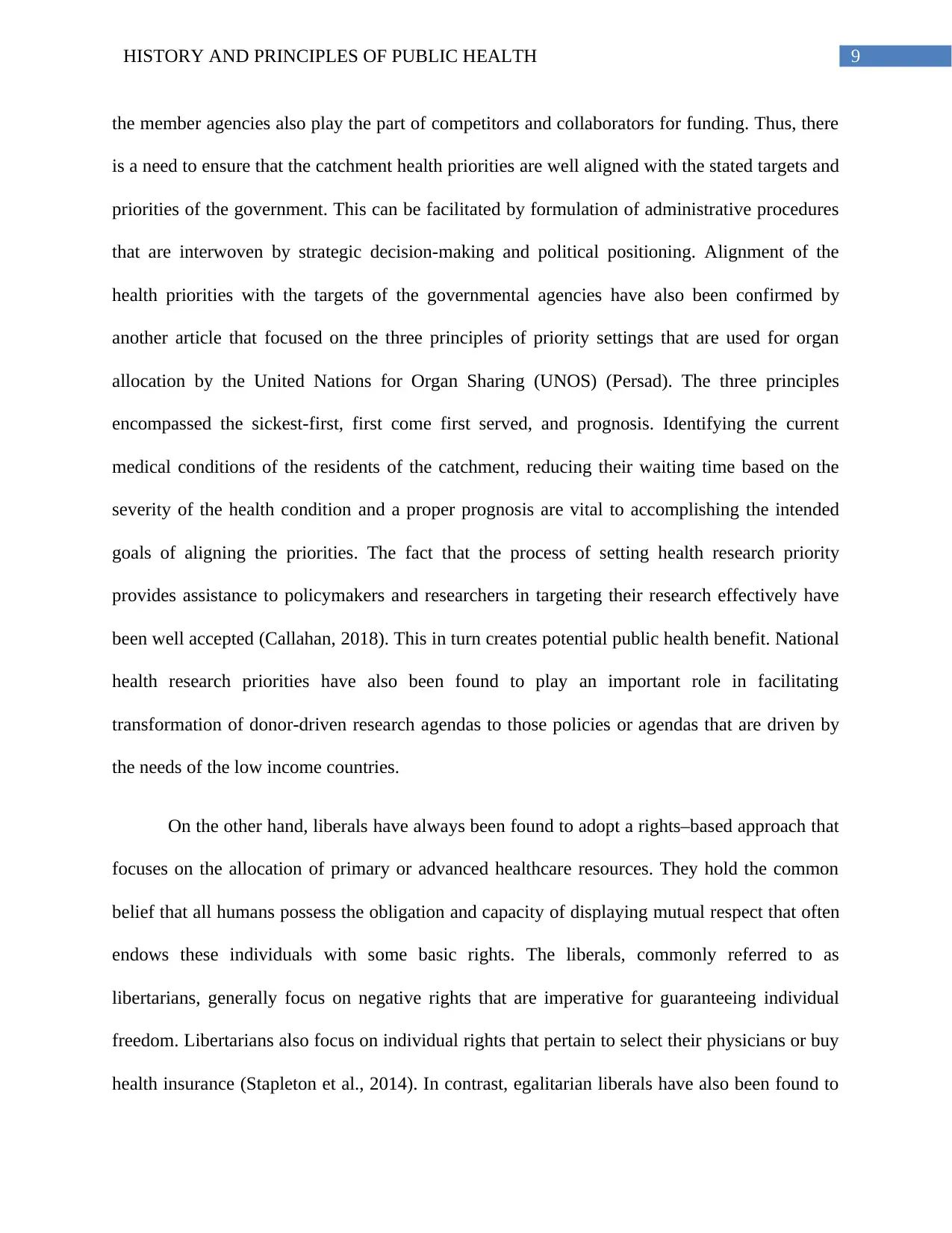
9HISTORY AND PRINCIPLES OF PUBLIC HEALTH
the member agencies also play the part of competitors and collaborators for funding. Thus, there
is a need to ensure that the catchment health priorities are well aligned with the stated targets and
priorities of the government. This can be facilitated by formulation of administrative procedures
that are interwoven by strategic decision-making and political positioning. Alignment of the
health priorities with the targets of the governmental agencies have also been confirmed by
another article that focused on the three principles of priority settings that are used for organ
allocation by the United Nations for Organ Sharing (UNOS) (Persad). The three principles
encompassed the sickest-first, first come first served, and prognosis. Identifying the current
medical conditions of the residents of the catchment, reducing their waiting time based on the
severity of the health condition and a proper prognosis are vital to accomplishing the intended
goals of aligning the priorities. The fact that the process of setting health research priority
provides assistance to policymakers and researchers in targeting their research effectively have
been well accepted (Callahan, 2018). This in turn creates potential public health benefit. National
health research priorities have also been found to play an important role in facilitating
transformation of donor-driven research agendas to those policies or agendas that are driven by
the needs of the low income countries.
On the other hand, liberals have always been found to adopt a rights–based approach that
focuses on the allocation of primary or advanced healthcare resources. They hold the common
belief that all humans possess the obligation and capacity of displaying mutual respect that often
endows these individuals with some basic rights. The liberals, commonly referred to as
libertarians, generally focus on negative rights that are imperative for guaranteeing individual
freedom. Libertarians also focus on individual rights that pertain to select their physicians or buy
health insurance (Stapleton et al., 2014). In contrast, egalitarian liberals have also been found to
the member agencies also play the part of competitors and collaborators for funding. Thus, there
is a need to ensure that the catchment health priorities are well aligned with the stated targets and
priorities of the government. This can be facilitated by formulation of administrative procedures
that are interwoven by strategic decision-making and political positioning. Alignment of the
health priorities with the targets of the governmental agencies have also been confirmed by
another article that focused on the three principles of priority settings that are used for organ
allocation by the United Nations for Organ Sharing (UNOS) (Persad). The three principles
encompassed the sickest-first, first come first served, and prognosis. Identifying the current
medical conditions of the residents of the catchment, reducing their waiting time based on the
severity of the health condition and a proper prognosis are vital to accomplishing the intended
goals of aligning the priorities. The fact that the process of setting health research priority
provides assistance to policymakers and researchers in targeting their research effectively have
been well accepted (Callahan, 2018). This in turn creates potential public health benefit. National
health research priorities have also been found to play an important role in facilitating
transformation of donor-driven research agendas to those policies or agendas that are driven by
the needs of the low income countries.
On the other hand, liberals have always been found to adopt a rights–based approach that
focuses on the allocation of primary or advanced healthcare resources. They hold the common
belief that all humans possess the obligation and capacity of displaying mutual respect that often
endows these individuals with some basic rights. The liberals, commonly referred to as
libertarians, generally focus on negative rights that are imperative for guaranteeing individual
freedom. Libertarians also focus on individual rights that pertain to select their physicians or buy
health insurance (Stapleton et al., 2014). In contrast, egalitarian liberals have also been found to
Paraphrase This Document
Need a fresh take? Get an instant paraphrase of this document with our AI Paraphraser
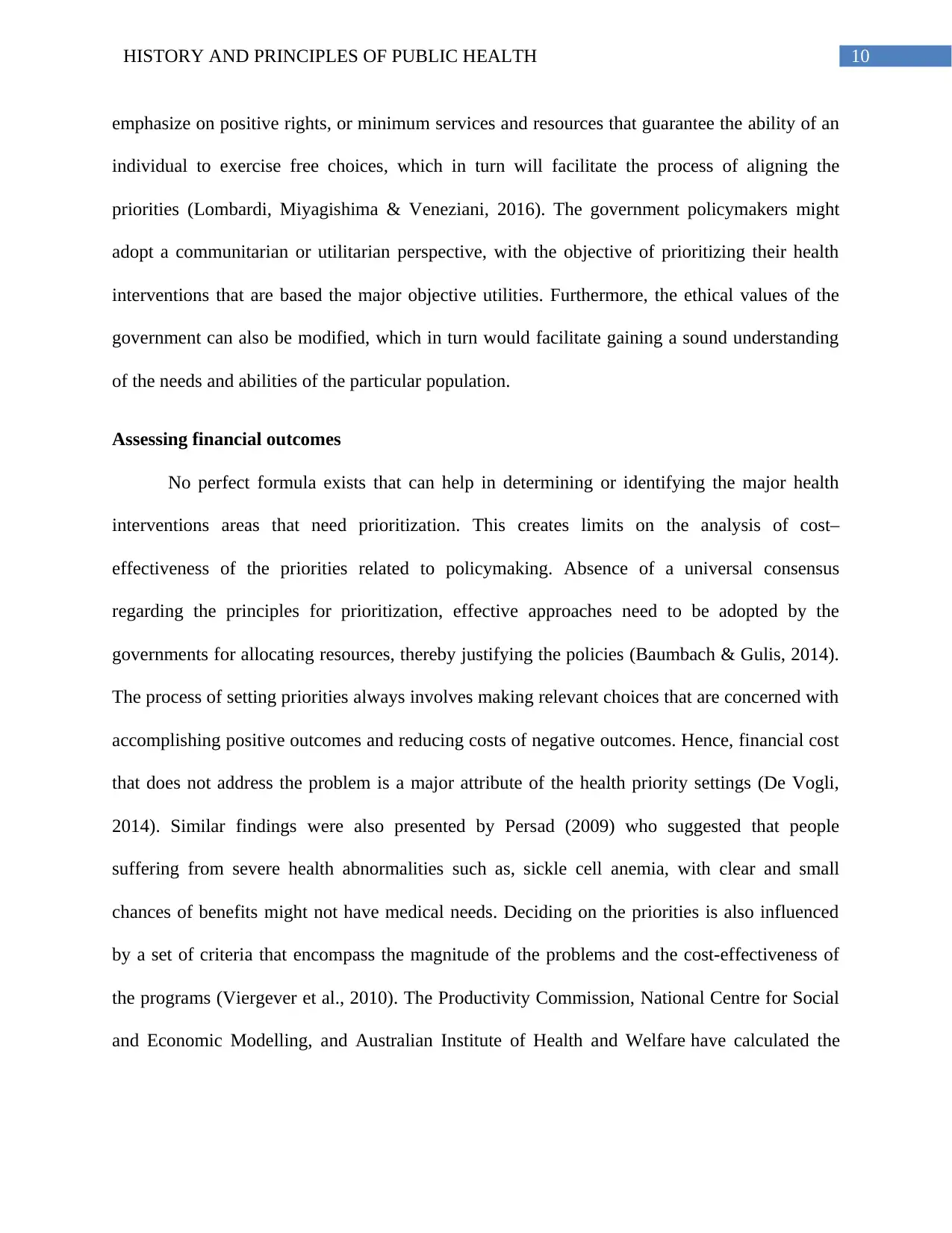
10HISTORY AND PRINCIPLES OF PUBLIC HEALTH
emphasize on positive rights, or minimum services and resources that guarantee the ability of an
individual to exercise free choices, which in turn will facilitate the process of aligning the
priorities (Lombardi, Miyagishima & Veneziani, 2016). The government policymakers might
adopt a communitarian or utilitarian perspective, with the objective of prioritizing their health
interventions that are based the major objective utilities. Furthermore, the ethical values of the
government can also be modified, which in turn would facilitate gaining a sound understanding
of the needs and abilities of the particular population.
Assessing financial outcomes
No perfect formula exists that can help in determining or identifying the major health
interventions areas that need prioritization. This creates limits on the analysis of cost–
effectiveness of the priorities related to policymaking. Absence of a universal consensus
regarding the principles for prioritization, effective approaches need to be adopted by the
governments for allocating resources, thereby justifying the policies (Baumbach & Gulis, 2014).
The process of setting priorities always involves making relevant choices that are concerned with
accomplishing positive outcomes and reducing costs of negative outcomes. Hence, financial cost
that does not address the problem is a major attribute of the health priority settings (De Vogli,
2014). Similar findings were also presented by Persad (2009) who suggested that people
suffering from severe health abnormalities such as, sickle cell anemia, with clear and small
chances of benefits might not have medical needs. Deciding on the priorities is also influenced
by a set of criteria that encompass the magnitude of the problems and the cost-effectiveness of
the programs (Viergever et al., 2010). The Productivity Commission, National Centre for Social
and Economic Modelling, and Australian Institute of Health and Welfare have calculated the
emphasize on positive rights, or minimum services and resources that guarantee the ability of an
individual to exercise free choices, which in turn will facilitate the process of aligning the
priorities (Lombardi, Miyagishima & Veneziani, 2016). The government policymakers might
adopt a communitarian or utilitarian perspective, with the objective of prioritizing their health
interventions that are based the major objective utilities. Furthermore, the ethical values of the
government can also be modified, which in turn would facilitate gaining a sound understanding
of the needs and abilities of the particular population.
Assessing financial outcomes
No perfect formula exists that can help in determining or identifying the major health
interventions areas that need prioritization. This creates limits on the analysis of cost–
effectiveness of the priorities related to policymaking. Absence of a universal consensus
regarding the principles for prioritization, effective approaches need to be adopted by the
governments for allocating resources, thereby justifying the policies (Baumbach & Gulis, 2014).
The process of setting priorities always involves making relevant choices that are concerned with
accomplishing positive outcomes and reducing costs of negative outcomes. Hence, financial cost
that does not address the problem is a major attribute of the health priority settings (De Vogli,
2014). Similar findings were also presented by Persad (2009) who suggested that people
suffering from severe health abnormalities such as, sickle cell anemia, with clear and small
chances of benefits might not have medical needs. Deciding on the priorities is also influenced
by a set of criteria that encompass the magnitude of the problems and the cost-effectiveness of
the programs (Viergever et al., 2010). The Productivity Commission, National Centre for Social
and Economic Modelling, and Australian Institute of Health and Welfare have calculated the

11HISTORY AND PRINCIPLES OF PUBLIC HEALTH
costs of several reforms, initiatives, and health problems that have assisted in the procedure of
setting health priorities (Gopalan et al., 2014).
Potential for improvement
These policies and strategies adopted by the government ensure that health inequalities
that have been properly identified are reduced to their bare minimum, upon their appropriate
implementation. Adoption of appropriate strategies systems will promote gender equity,
strengthen the nationals and local government and improve the overall health of vulnerable
individuals. Efforts must be taken by all the government agencies to bring about improvements
in minimizing inequities that exist in the health sector, thereby shattering the shackles of poverty
and health access inequalities. Provisions must be created for mechanisms related to disputes and
challenges, which in turn would provide opportunities for improvement and revision of those
policies, in regards to new arguments evidences.
Conclusion
To conclude, enforcing policies and legislation that increase the government funding that
are spent on health priority identification and reduction are alone not efficient to improve the
major health outcomes, in cases when the funds are not efficiently spent. Health outcomes can be
improved if there is an increase in the efficiency of government health spending, without total
budget expenditure increase. Increases in the efficiency of health spending among all nations
would also result in an elevation in the regional average of life expectancy. Furthermore,
universal health coverages should also be given their due recognition owing to the impacts that
they exert on health related financial risk protection. There is a need to create provisions for
increasing the budget allocation related to health. An improvement in the population health will
costs of several reforms, initiatives, and health problems that have assisted in the procedure of
setting health priorities (Gopalan et al., 2014).
Potential for improvement
These policies and strategies adopted by the government ensure that health inequalities
that have been properly identified are reduced to their bare minimum, upon their appropriate
implementation. Adoption of appropriate strategies systems will promote gender equity,
strengthen the nationals and local government and improve the overall health of vulnerable
individuals. Efforts must be taken by all the government agencies to bring about improvements
in minimizing inequities that exist in the health sector, thereby shattering the shackles of poverty
and health access inequalities. Provisions must be created for mechanisms related to disputes and
challenges, which in turn would provide opportunities for improvement and revision of those
policies, in regards to new arguments evidences.
Conclusion
To conclude, enforcing policies and legislation that increase the government funding that
are spent on health priority identification and reduction are alone not efficient to improve the
major health outcomes, in cases when the funds are not efficiently spent. Health outcomes can be
improved if there is an increase in the efficiency of government health spending, without total
budget expenditure increase. Increases in the efficiency of health spending among all nations
would also result in an elevation in the regional average of life expectancy. Furthermore,
universal health coverages should also be given their due recognition owing to the impacts that
they exert on health related financial risk protection. There is a need to create provisions for
increasing the budget allocation related to health. An improvement in the population health will
⊘ This is a preview!⊘
Do you want full access?
Subscribe today to unlock all pages.

Trusted by 1+ million students worldwide
1 out of 16
Related Documents
Your All-in-One AI-Powered Toolkit for Academic Success.
+13062052269
info@desklib.com
Available 24*7 on WhatsApp / Email
![[object Object]](/_next/static/media/star-bottom.7253800d.svg)
Unlock your academic potential
Copyright © 2020–2025 A2Z Services. All Rights Reserved. Developed and managed by ZUCOL.





